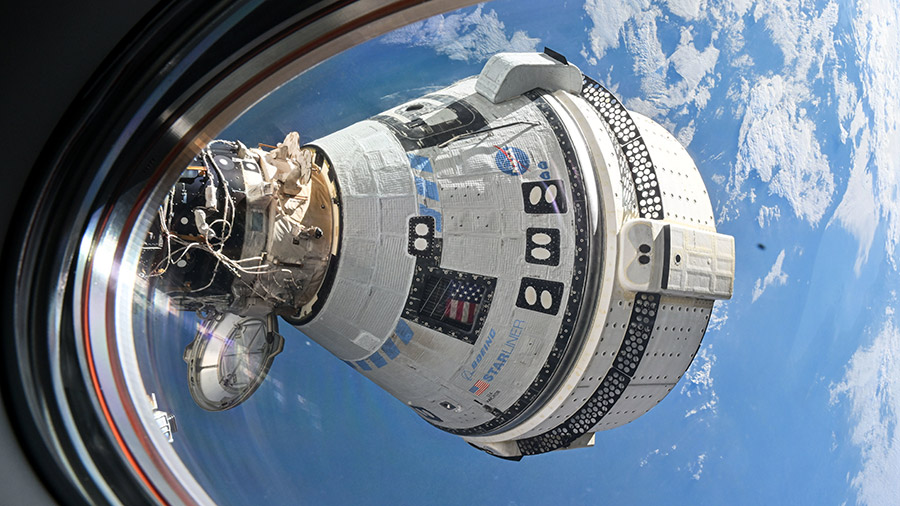
Mission managers have given the first “go” for the Boeing Starliner spacecraft to undock from the International Space Station at 6:04 p.m. EDT on Friday and land in New Mexico about six hours later. NASA astronauts Butch Wilmore and Suni Williams have finished packing Starliner with cargo and configuring its cabin for return. The duo closed Starliner’s hatch for the final time Thursday afternoon readying the spacecraft for its uncrewed departure.
Wilmore and Williams will remain aboard the orbital outpost until February when they are scheduled to return to Earth aboard the SpaceX Dragon spacecraft with the Crew-9 mission. Starliner’s departure coverage begins at 5:45 p.m. Friday on NASA+, the NASA app, YouTube, and the agency’s website.
In the meantime, a multitude of science occurred aboard the orbital outpost on Thursday with the crew exploring microgravity’s effect on the heart and breathing, space botany, fire safety, and Earth observations. Scientists on the ground analyze the research data for unique insights on improving human health on and off the planet as well as promoting Earth and space industries.
Expedition 71 Flight Engineer Tracy C. Dyson kicked off her day wearing a sensor-packed headband and vest while pedaling on an exercise cycle inside the Destiny laboratory module. Her cardio-respiratory data was recorded to a computer helping scientists understand how weightlessness affects a crew member’s blood pressure and breathing.
NASA astronaut Mike Barratt photographed and watered plants growing for the C4 Photosynthesis in Space experiment inside the Columbus laboratory module’s Veggie space botany facility. The investigation observes space-caused photosynthesis and plant metabolism changes in two types of grasses growing inside the EXPRESS Rack’s Veggie research device. Results may inform bioregenerative life support systems on future spacecraft and boost fundamental knowledge of botanical processes on Earth.
Fire safety on spacecraft is just as critical and important as fire safety on Earth. However, flames and materials burn differently in the weightless environment requiring a different approach to fire protection. Researchers are using the space station’s Combustion Integrated Rack (CIR) to safely study flames in space to learn how to protect spacecraft and space habitats. NASA Flight Engineer Jeanette Epps swapped components and removed burnt samples inside the CIR for a series of experiments exploring space flammability and fire suppression in microgravity.
Pointing his camera out a window in the cupola and toward the Moon, NASA Flight Engineer Matthew Dominick photographed light reflecting off the lunar surface illuminated from Earth, also called earthshine. Measuring changes in Earth’s light reflected from the Moon may help scientists update their climate models and inform the design of future atmosphere observing satellites.
Roscosmos Commander Oleg Kononenko spent his day preparing for upcoming Soyuz spacecraft operations. The five-time station resident is collecting cargo that will soon be packed in the Soyuz MS-25 spacecraft for its departure in late September. Afterward, the veteran cosmonaut readied the Rassvet module for the Sept. 11 docking of the Soyuz MS-26 crew ship bringing to the orbital lab NASA astronaut Don Pettit and Roscosmos cosmonauts Alexey Ovchinin and Ivan Wagner. Flight Engineers Nikolai Chub and Alexander Grebenkin split their day conducting a variety of Roscosmos research and lab maintenance tasks. Chub and Kononenko also participated in eye checks at the end of the day on Thursday.
The ISS Progress 89 cargo craft docked to the Zvezda service module’s rear port fired its thrusters at 3:45 p.m. for 13 minutes today raising the space station’s altitude. The orbital reboost is the third and final maneuver setting up the proper phasing for the arrival of the Soyuz MS-26 next week and Starliner’s undocking opportunity on Friday.
Learn more about station activities by following the space station blog, @space_station and @ISS_Research on X, as well as the ISS Facebook and ISS Instagram accounts.
Get weekly video highlights at: https://roundupreads.jsc.nasa.gov/videoupdate/
Get the latest from NASA delivered every week. Subscribe here: www.nasa.gov/subscribe
